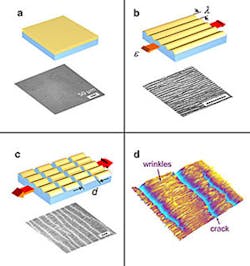Researchers at the National Institute of Standards and Technology (NIST) have demonstrated a measurement technique that is capable of determining three fundamental mechanical properties of near-nanoscale films. The technique should enable better design and engineering for a variety of thin-film technologies, particularly reverse-osmosis membranes for water purification.
Reverse-osmosis membranes are used in water purification systems. Water holding dissolved salts or other contaminants is forced against one side of the membrane at substantial pressures up to about a thousand PSI (roughly 7 megapascal), and comes out the other side leaving most of the impurities behind. The mechanical integrity of the membrane is essential — it can”t tear or develop pinhole leaks under the pressure — but engineers lacked a good way to measure the strength and breaking point, under stress, of these extremely thin films.
The NIST technique builds on earlier work by the team that demonstrated that you can reliably determine Young”s modulus — a measure of stiffness or elasticity — for thin and ultrathin films by bonding it to a piece of silicon rubber and then carefully stretching it in one direction. The film will develop a regularly spaced pattern of wrinkles (try it with a piece of plastic wrap), and the spacing of the wrinkles, the amount of stretch and some math gives you the modulus. In the new work, they basically pull harder until the film starts developing minute cracks crosswise to the tension. These too, it turns out, occur in regular patterns, and the spacing can be analyzed to determine both the fracture strength and the onset fracture strain, or the failure point, of the film.
Nanomechanical measurements (model system and microimage of typical specimen). a) thin rigid film on elastic substrate b) initial strain induces surface wrinkles parallel to stress c) additional strain induces regular pattern of cracks in the film d) typical specimen imaged with optical profilometer (280 X 210 micrometers.)
Image courtesy of Chung, Lee/NIST
Applying their technique to study the effect of chlorine on reverse-osmosis membranes, the team uncovered a puzzle. Chlorine in the water is known to cause a progressive deterioration in membrane performance, generally thought to be the result of prolonged chemical attack by the chlorine. But the NIST team found that all the chemical damage from chlorine exposure happens in the first few hours. Tests using the wrinkle-crack method, however, show that the mechanical properties degrade continuously — the material becoming more and more stiff, brittle and weak — up to the longest duration tested, 10 days. The researchers speculate it may be an aging effect in polymers and are continuing to study it.
The project is part of a broader NIST program to study materials issues related to sustainable technologies like water purification, but the research team notes that the wrinkle-crack method itself would be broadly applicable to mechanical studies of almost any nanoscale thin film in fields as diverse as artificial skin, flexible electronics, thin-film sensors, fuel cells and photovoltaics.
For the full NIST report on this story, click here.


